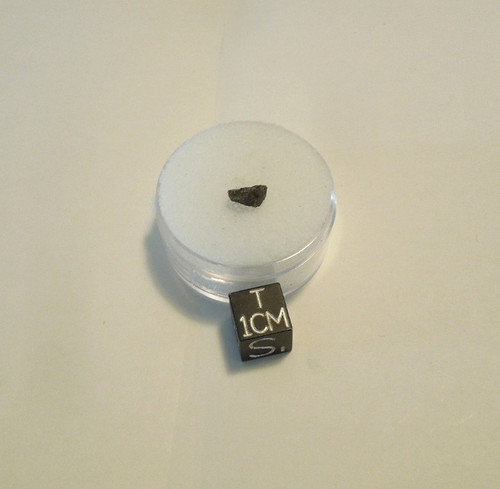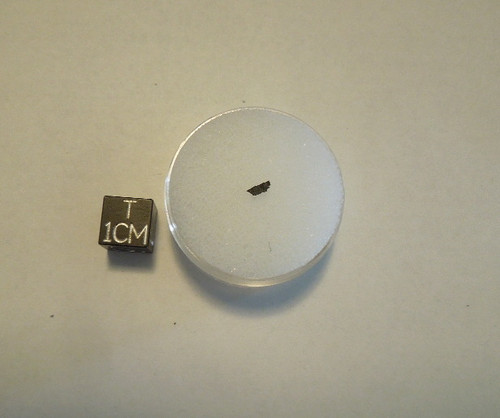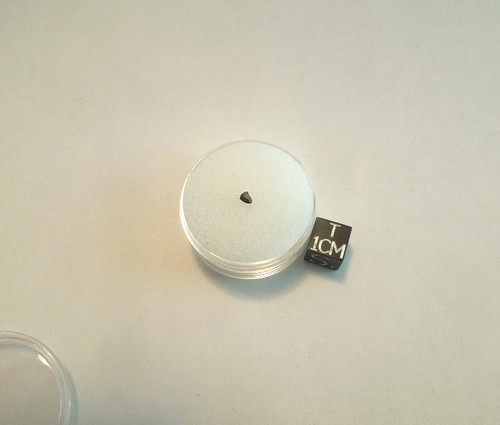Hassi Khebi 001 meteorites were recovered out of the Tindouf province of Algeria in 2022. Many small broken stones and fragments were found. They had a distinctively frothy fusion crust and broken surfaces showed many tiny chondrules, CAI's, and clasts contrasted against a charcoal-black matrix. Analysis and classification took place at UNM by Dr. Carl Agee. As expected, this meteorite was a carbonaceous chondrite, but the oxygen isotope plot placed it outside the domain of known carbonaceous classes. The official classification is "C3-ungrouped" and it is one of only 31 known meteorites of this type.
Visually, this meteorite resembles an aesthetically-pleasing carbonaceous matrix that is not unlike Allende or Murchison, except with fewer CAI inclusions. The fusion crust and matrix is relatively fresh, so while this is not a recent fall, it is not an ancient weathered example either. For collectors, this is a good example of a rare/exotic type and it represents the first catalog entry on a new dense collection area (Hassi Khebi).
Refer to the photo. The black centimeter cube is shown for scale and is not included. You are purchasing a small fragment like the one shown. Your purchase will include a labeled gemjar for safe storage.
From the Meteoritical Bulletin entry on Hassi Khebi 001 :
Hassi Khebi 001 29°09’28.3"N, 4°55’43.3"W
Tindouf, Algeria
Purchased: 2022
Classification: Carbonaceous chondrite (C3, ungrouped)
History: Purchased by Matthew Stream from an Algerian meteorite dealer in August 2022. Found approximately 15 km southeast of Hassi Khébi in Tindouf Province, Algeria.
Physical characteristics: Dark gray/black fusion-crusted exterior, saw cut surface reveals scattered well-formed chondrules set in a black matrix that makes up over 50% of this meteorite. Some of the chondrules appear to have orange iron-staining. Rare small CAIs are visible.
Petrography: (C. Agee and M. Spilde, UNM) Electron microprobe examination reveals a fine-grained matrix that gives slightly low microprobe totals (~95%) consistent with the absence of significant hydrous phases. Most chondrules are porphyritic type I with predominantly forsteritic olivines and enstatitic pyroxenes. Apparent mean chondrule diameter is 275±227 μm (n=50). Kamacite and Fe-Ni sulfide are the dominant opaque phases. Cr-magnetite was not detected. Vesicular fusion crust is 200-300 µm thick.
Geochemistry: (M. Spilde and C. Agee, UNM) Type I chondrule olivine Fa1.3±1.4, Cr2O3=0.34±0.16 (wt%) n=24; low-Ca pyroxene Fs1.6±0.8Wo1.6±1.5, n=9; matrix (20 μm defocused microprobe beam) SiO2=31.5±5.3, TiO2=0.32±0.66, Cr2O3=0.43±0.14, Al2O3=4.4±3.6, FeO=29.6±9.7, MgO=15.7±3.7, CaO=3.0±3.4, NiO=1.6±0.3, MnO=0.21±0.07, Na2O=0.18±0.05, K2O=0.27±0.15, SO3=7.3±3.6 (all wt%), n=7., with total around 95 wt% not consistent with significant hydrous phases being present. Fusion crust, proxy from bulk composition (20 µm defocused microprobe beam) SiO2=43.5±2.5, TiO2=0.17±0.01, Cr2O3=0.58±0.04, Al2O3=4.2±0.5, FeO=19.5±4.0, MgO=28.2±2.5, CaO=3.1±0.3, NiO=0.10±0.07, MnO=0.35±0.01, Na2O=0.83±0.12, K2O=0.07±0.01 (all wt%), n=7. Oxygen isotopes (K. Ziegler, UNM): 3 acid-washed fragments analyzed by laser fluorination gave δ17O=-6.509,-7.235,-9.497; δ18O=-1.497, -2.483, -5.165 (all ‰).
Classification: Carbonaceous chondrite ungrouped (C3). Oxygen isotopic compositions are significantly displaced below the CCAM indicating ungrouped carbonaceous chondrite. Type 3 based on a predominantly anhydrous matrix and Cr2O3 content of olivine.





